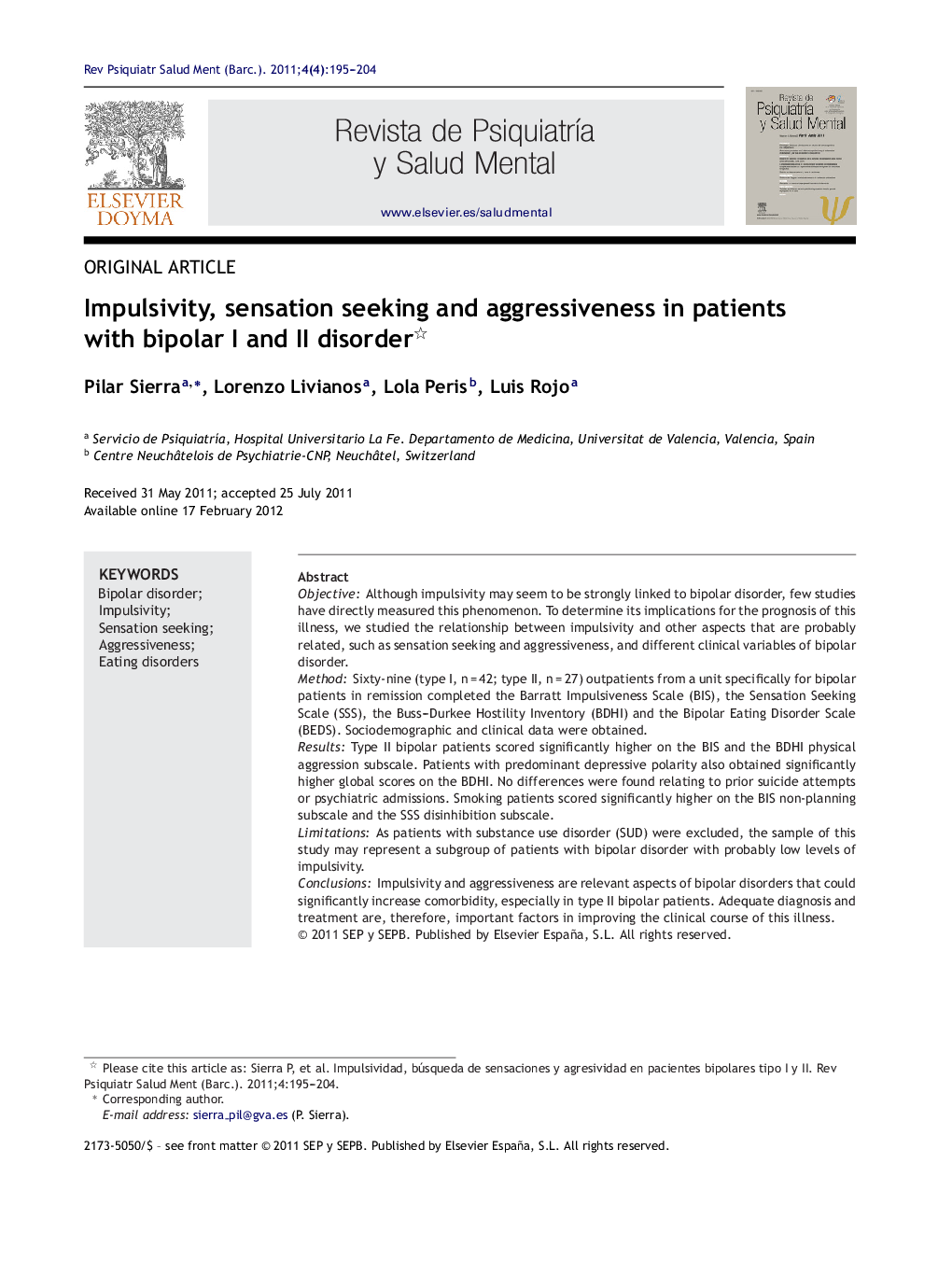| کد مقاله | کد نشریه | سال انتشار | مقاله انگلیسی | نسخه تمام متن |
|---|---|---|---|---|
| 4191607 | 1278296 | 2011 | 10 صفحه PDF | دانلود رایگان |

ObjectiveAlthough impulsivity may seem to be strongly linked to bipolar disorder, few studies have directly measured this phenomenon. To determine its implications for the prognosis of this illness, we studied the relationship between impulsivity and other aspects that are probably related, such as sensation seeking and aggressiveness, and different clinical variables of bipolar disorder.MethodSixty-nine (type I, n = 42; type II, n = 27) outpatients from a unit specifically for bipolar patients in remission completed the Barratt Impulsiveness Scale (BIS), the Sensation Seeking Scale (SSS), the Buss–Durkee Hostility Inventory (BDHI) and the Bipolar Eating Disorder Scale (BEDS). Sociodemographic and clinical data were obtained.ResultsType II bipolar patients scored significantly higher on the BIS and the BDHI physical aggression subscale. Patients with predominant depressive polarity also obtained significantly higher global scores on the BDHI. No differences were found relating to prior suicide attempts or psychiatric admissions. Smoking patients scored significantly higher on the BIS non-planning subscale and the SSS disinhibition subscale.LimitationsAs patients with substance use disorder (SUD) were excluded, the sample of this study may represent a subgroup of patients with bipolar disorder with probably low levels of impulsivity.ConclusionsImpulsivity and aggressiveness are relevant aspects of bipolar disorders that could significantly increase comorbidity, especially in type II bipolar patients. Adequate diagnosis and treatment are, therefore, important factors in improving the clinical course of this illness.
ResumenIntroducciónAunque la impulsividad puede aparecer fuertemente relacionada con el trastorno bipolar, pocos estudios han medido directamente este fenómeno. Con el objetivo de conocer sus implicaciones pronósticas, estudiamos la relación entre la impulsividad y otros aspectos probablemente relacionados con ella, como son la búsqueda de sensaciones y la agresividad y diferentes variables clínicas del trastorno bipolar.Métodos69 pacientes ambulatorios en remisión (tipo I, n = 42; tipo II, n = 27) de una unidad específica de trastornos bipolares completaron la Escala de Impulsividad Barratt (BIS), la Escala de Búsqueda de Sensaciones (SSS), el Inventario de Hostilidad de Buss–Durkee (BDHI) y la Escala para las Alteraciones de la Conducta Alimentaria en el Trastorno Bipolar (BEDS). Se obtuvieron datos clínicos y sociodemográficos.ResultadosLos bipolares tipo II obtuvieron puntuaciones significativamente más elevadas en la BIS y en la subescala de agresividad física del BDHI. En los pacientes en los que predominaba la polaridad depresiva, las puntuaciones globales en el BDHI eran significativamente más elevadas. No se encontraron diferencias en función de los antecedentes de intentos de suicidio o de ingresos psiquiátricos. Los pacientes fumadores puntuaron de forma significativamente más alta en la Subescala de no planificación de la Barratt y en la Subescala de desinhibición de la SSS.LimitacionesDado que los pacientes con abuso de sustancias fueron excluidos, la muestra de este estudio puede representar un subgrupo de pacientes bipolares con niveles más bajos de impulsividad.ConclusionesLa impulsividad y la agresividad son aspectos relevantes en los trastornos bipolares que podrían incrementar de un modo significativo la comorbilidad, especialmente en subtipo II. Por lo tanto un adecuado diagnóstico y tratamiento de ambos son importantes a la hora de mejorar el curso clínico de esta enfermedad.
Journal: Revista de Psiquiatría y Salud Mental (English Edition) - Volume 4, Issue 4, October–December 2011, Pages 195–204